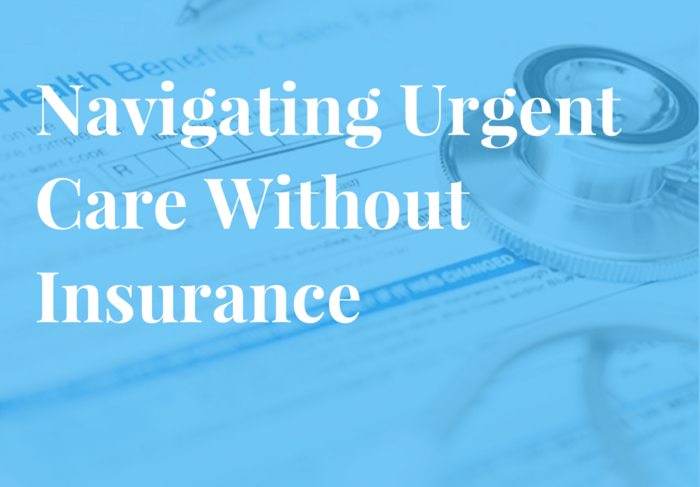
Feel better faster. Get care today.
From the clinic or your couch. Find high quality, same-day urgent care for you and your kids. Book an urgent care visit today.

It’s no secret that more and more Americans are taking on health plans with outrageously high deductibles or dropping their health insurance coverage altogether. Several studies have highlighted the millions of people of all ages in the United States that are lacking health coverage—or lacking affordable health coverage, which often prevents them from seeking care they need.
If this sounds familiar, know you’re not alone. In fact, “in the first 6 months of 2017, 28.8 million (9.0%) persons of all ages were uninsured,” according to the 2017 National Health Interview Survey.” As insurance coverage has dropped, more and more people are turning to urgent care as a more affordable alternative to hospital emergency rooms or primary care doctor’s offices. If you need to go to urgent care, it’s a good idea to know how much you’ll be expected to pay ahead of time, especially if you don’t have insurance to help supplement the cost of care.
At the same time that healthcare organizations, including urgent care centers, are being encouraged to provide price transparency, patients are shouldering a heavier burden of payment responsibility. If both patients and providers take initiative to understand and communicate healthcare costs, the result will be greater transparency, more affordability, and better care.
Below, learn how much an urgent care visit costs, whether you should go to urgent care if you don’t have insurance, and how to save money at urgent care.
Put simply, the amount you’ll pay depends on what your visit is for. Debt.org shared the below table, which was originally prepared by Medica Choice Network. The table outlines nine of the most common reasons people visit the ER, determined by calculating the average number of claims submitted in 2010 to the Medica Choice Network:
“The Annals of Internal Medicine study found that the average cost of an urgent care visit for three common illnesses — middle ear infection, pharyngitis and urinary tract infection — was $155. Other estimates place the average urgent care visit at anywhere from $71 to $125. The bottom line is that an urgent care visit is substantially cheaper than an emergency room visit.”
| Condition | Emergency Room Cost | Urgent Care Cost |
|---|---|---|
| Allergies | $345 | $97 |
| Acute Bronchitis | $595 | $127 |
| Earache | $400 | $110 |
| Sore Throat | $525 | $94 |
| Pink Eye | $370 | $102 |
| Sinusitis | $617 | $112 |
| Strep Throat | $531 | $111 |
| Upper Respiratory Infection | $486 | $111 |
| Urinary Tract Infection | $665 | $112 |
When you book an urgent care appointment on Solv, we list the cash/self-pay prices for each walk-in clinic, so you know what you’ll be expected to pay ahead of time. If you’re paying for care on your own, let the urgent care center know. Sometimes they’ll offer a discount or interest fee payment plan if they know you don’t have insurance.
Without health insurance, urgent care is a much better choice than the ER for minor, acute issues. As shown in the above table, the amount you may pay at the ER can be three to four times higher than what you’d pay to be treated for the same issue at urgent care. Many people go to the ER because they know they’ll have to be treated, even without insurance. Urgent care centers will also treat you without insurance and many will offer payment plans if you can’t pay upfront.
Though urgent care is almost always cheaper than going to the ER and, for people without insurance, can be cheaper than going to see a regular doctor, the cost may still seem overwhelming if you’re paying out-of-pocket. According to a Kaiser Family Foundation survey, almost half of people without insurance have trouble with medical bills. Thankfully, since so many people are dealing with high deductibles and a lack of insurance, many healthcare facilities are taking steps to ensure that people can afford care.
For non-life-threatening conditions, urgent care is a great option for uninsured patients. Especially if you use Solv to make an appointment, you’ll be seen a lot faster — most patients wait less than 20 minutes to see a medical provider. Urgent care is also a lot less expensive. Cigna, a major insurance provider, estimates that an average ER visit costs $2,259, while an average urgent care visit costs just $176—a significant difference. The next time you or your child needs medical attention after hours, keep this guide in mind. For minor, acute conditions, a trip to urgent care will get you answers and relief a whole lot faster than the ER, and at a fraction of the cost.
Yes, urgent care is a more affordable alternative to hospital emergency rooms or primary care doctor’s offices for uninsured individuals.
The cost varies depending on the reason for the visit, but it is substantially cheaper than an emergency room visit, with estimates ranging from $71 to $155 on average.
Yes, many urgent care centers offer discounts or payment plans for uninsured patients.
You can save money by looking up rates online, asking about discounted rates, payment plans, and generic prescriptions, and double-checking your bills.
Yes, urgent care centers will treat you without insurance and many will offer payment plans if you can’t pay upfront.
Most patients wait less than 20 minutes to see a medical provider at an urgent care center.
An average ER visit costs $2,259, while an average urgent care visit costs just $176. This makes urgent care a much more affordable option.
Some common conditions treated at urgent care centers include allergies, acute bronchitis, earache, sore throat, pink eye, sinusitis, strep throat, upper respiratory infection, and urinary tract infection.

From the clinic or your couch. Find high quality, same-day urgent care for you and your kids. Book an urgent care visit today.